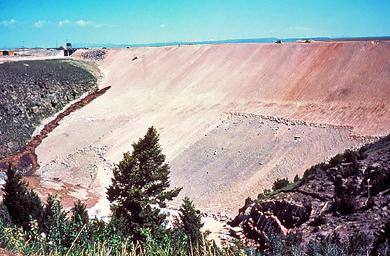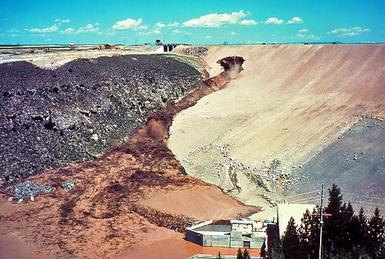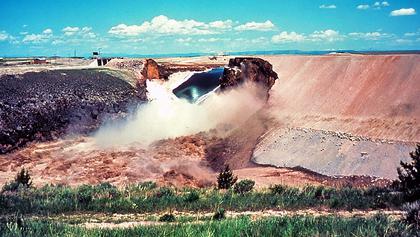Teton Dam

Catastrophic failure on June 5, 1976
Location: Fremont & Madison counties, Idaho
Coordinates:
43°54?35?N 111°32?21?W
Purpose: Flood control, irrigation
Construction began: 1972
Opening date: 1976
Demolition date: June 5, 1976 (failure)
The
Teton Dam was an earthen dam on the Teton River in Idaho, United States. It was built by the Bureau of Reclamation, one of eight federal agencies authorized to construct dams. Located in the eastern part of the state, between Fremont and Madison counties, it suffered a catastrophic failure on June 5, 1976, as it was filling for the first time.
The collapse of the dam resulted in the deaths of eleven people[4] and 16,000 livestock. The dam cost about $100 million to build and the federal government paid over $300 million in claims related to its failure. Total damage estimates have ranged up to $2 billion. The dam has not been rebuilt.
{snip}
Collapse and flood

The dark brown streak on the dam face near the gray bedrock in the left half of the photo is a leak that formed on the morning of June 5. The speck above the leak near the top of the dam is a D9 bulldozer on its way to push soil into the leak.

Large amounts of mud are now spilling down the face of the dam, unchecked by the efforts of the bulldozer operators. The outlet works at the foot of the dam are flooding with muddy water.

The dam is now breached and muddy water flows violently over the dam face.

The breach has now widened to nearly its full extent. The outlet works are completely inundated with muddy water.
On Saturday, June 5, 1976, at 7:30 am MDT, a muddy leak appeared, suggesting sediment was in the water, but engineers did not believe there was a problem. By 9:30 am, the downstream face of the dam had developed a wet spot, which began to discharge water at 20 to 30 cubic feet per second (0.57 to 0.85 m3/s) and the embankment material began to wash out. Crews with bulldozers were sent to plug the leak, but were unsuccessful. Local media appeared at the site and at 11:15, officials told the county sheriff's office to evacuate downstream residents. Work crews were forced to flee on foot as the widening gap, now larger than a swimming pool, swallowed their equipment. The operators of two bulldozers caught in the eroding embankment were pulled to safety with ropes.
At 11:55 am MDT (UTC?17:55), the crest of the dam sagged and collapsed into the reservoir; two minutes later, the remainder of the right-bank third of the main dam wall disintegrated. Over 2,000,000 cubic feet per second (57,000 m3/s) (many times the average flow rate of Niagara Falls) of sediment-filled water emptied through the breach into the remaining 6 miles (10 km) of the Teton River canyon, after which the flood spread out and shallowed on the Snake River Plain. By 8:00 pm, the reservoir had completely emptied, although over two-thirds of the dam wall remained standing.
{snip}




